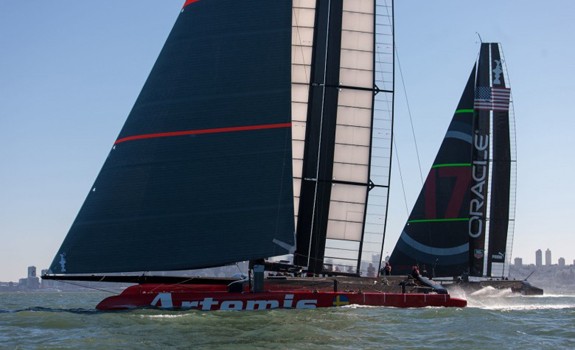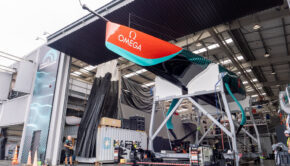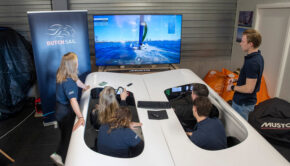Paul Cayard: Foiling and the America’s Cup
Published on March 4th, 2013
 Following their tuning sessions in February with America’s Cup defender Oracle Team USA, Swedish challenger Artemis Racing announced they had halted their AC72 sailing program and would be proceeding with modifications to the boat. Considering that Artemis Racing is the only team that does not have a fully foiling boat, it was time to check in with team CEO Paul Cayard.
Following their tuning sessions in February with America’s Cup defender Oracle Team USA, Swedish challenger Artemis Racing announced they had halted their AC72 sailing program and would be proceeding with modifications to the boat. Considering that Artemis Racing is the only team that does not have a fully foiling boat, it was time to check in with team CEO Paul Cayard.
Here’s the two part report that Paul shared with Scuttlebutt’s Craig Leweck:
Part 1 –
Sailing against Oracle was a full-scale verification that we needed to make some pretty big changes, and that’s what we are doing. We are taking it on. The good news is that we learned this in February and not in July. So we have some time to react. But we need to commit more to foiling.
When discussing foiling, it is important to understand that it is not black and white. It is a spectrum, and what we are really saying when we say ‘foiling’ is that we are reducing displacement of the boat. The lifting occurs through the foils on the rudder and the daggerboard design. On a spectrum between zero and the full weight of the boat, a fully foiling boat is lifting the full weight of the boat.
Our boat had J boards, and while they lift a percentage of our displacement, they do not lift all of it. The game of foiling is trading off the drag associated with the boards. The fully foiling boats use L boards, but both the surface area of these boards, and the tightness of the L board angle, create more drag than the J board. However, they also cause more lift.
So each team’s design tools predicted what the cost of the drag would be, and what the benefit of the lift would be, and it is fair to say that we got it wrong. So now we are reacting. Our team has come together, and is fully committed to tackling this issue full on.
Some of the aspects of the L boards that we will need to discover is their impact on maneuverability and downspeed acceleration. This had been a concern of ours, but our experience training with Oracle Team USA is that their L boards didn’t’ seem to be much of a hindrance, if any. This factored in our decision to make the modifications to our boats.
In parallel, we are converting an AC45 to begin training sooner on a fully foiling boat. This will help fill the gap as our second boat is still a few months away, so this will give us a training platform for March. The end game is to be race ready by the start of the challenger trials in July and that’s where we are headed.
As for our changes, it is fair to say that we are going to be building a fully foiling boat. This will require a redesign of our boards and board cases, and rudders. It is a complete package once you go down that road. Boat #1 is now in the shed for three weeks, but we are doing work in some other areas, and are eager to get back on the water. It will not be a fully foiling boat when we re-launch. To fully convert this boat would keep us off the water for too long.
However, our second boat will now have a fully foiling package. The boat was already designed with greater foiling lift, and was very close to having full foiling ability. We called it skimming, wherein it was expected to lift roughly 80% of the hull’s displacement, meaning the hull is barely touching the water. But now that boat will have full foiling ability, though we will retain both full foil and skimming options to test. The changes will slightly delay the boat’s schedule, but we still expect to be sailing it by the end of May.
Obviously we are a little behind the eight ball on the foiling aspect of the AC72, but we have a sailing team that is suited as well as any other team to take on the challenge. I have been so impressed with our helm Nathan Outteridge, who mastered the foiling Moth to win their Worlds, and then to win the gold medal in the 49er skiff at the 2012 Games. In all the discussions we’ve had, he has been exceedingly confident in addressing these design needs now rather than use the time on the water. He believes the sailing team will figure it all out when the boat is ready.
Part 2 –
Different modes…
“With the focus on full foiling, it is important to recognize there are wind crossovers that impact the equation. If the winds are too light to fully foil, then the excessive drag caused by the foiling blades will be a big problem. While July and August are windy months on the Bay, September can offer a wider range of wind strength. The foiling package that works in the Louis Vuitton Cup (July 7 – Aug 31) may not work in the America’s Cup (Sept 7-23).”
Upwind foiling…
“So far no team has been able to fully foil upwind. We see it when reaching and running, but not closed hauled, and I don’t think we will see it in this America’s Cup. But remember, even if the boats are not fully foiling upwind, they are still foiling to a less degree. A good estimation is that about half of the boat’s displacement is getting lifted when sailing upwind.”
Reconnaissance…
“It has been pretty interesting watching Oracle sail since the time we trained with them. They now, along with most of the other teams, are sailing with two different boards at the same time. One board is more suited for upwind and less stable when sailing downwind, while the more ‘V’ shaped board is more stable for downwind but produce more drag when sailing upwind.
“We can learn from watching how the teams deal with the unsteadiness of the less draggy board. They might fly lower on the less stable board since that will minimize the hull pitch, whereas they will fly much higher on the stable board since they offer a much safer ride. But again, more stability when fully foiling off the wind means they are paying the price upwind with the additional drag of the stable board.”
More than foiling…
“While so much of the focus is on the foiling, it is good for the public to recognize that this America’s Cup is different in a lot of other ways too. When you consider the extreme conditions we expect in July and August, and the tightness of the race course, we are doing things no one has ever done before. Even in monohull racing, we have never been hemmed into a box that is just three quarters of a mile wide. The reaction time needed for the helm and crew is going to make a big difference. Add in how the boats are fragile, breakdowns are going to happen, and maintenance will be a big factor. There are just a lot of new factors that will be determining the outcome of this America’s Cup.”
Sailing photos by Sander van der Borch (upper) and Gilles Martin-Raget (lower).











 We’ll keep your information safe.
We’ll keep your information safe.